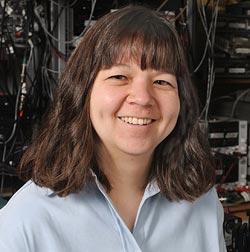
Manipulating the world of unseeable particles and unimaginably cold temperatures, Deborah Jin has helped forge a path into a new field of physics. She created the first fermionic gas—a heretofore unseen form of matter—by taking normally mutually repellent particles called fermions, cooling them, and then luring them into a single cohesive unit. Jin is being honored for her innovative studies of ultracold fermionic atoms and for the creation of the first quantum coherent gas of fermions - achievements that have opened a new area of quantum physics which bridges atomic, molecular, optical and condensed matter physics.
Born in 1968, Jin says she got a boost in physics from her mother, who had a master's degree in engineering physics. Jin attended Princeton University, where she earned an A.B. in physics in 1990. She went on to study at The University of Chicago, focusing on experimental work with exotic low-temperature superconductors. She completed her Ph.D. in 1995, at which point she became a research associate with the National Institute of Standards and Technology [NIST], working at JILA, a research institute devoted to high level physics, operated jointly by NIST and the University of Colorado at Boulder. There she was present at some of the initial experiments on Bose-Einstein condensates [BECs] conducted by Eric Cornell and Carl Wieman (recipients, along with Wolfgang Ketterle, of both the 2000 Benjamin Franklin Medal in Physics and the 2001 Nobel Prize for creating the first BECs). The first BECs represented the creation of an all new type of matter, the fruition of a prediction of what happens to atoms at low temperatures made by Einstein and Bose in 1925, and the achievement of reaching temperatures just billionths of a degree above absolute zero.
When Jin accepted a permanent position at NIST in 1997, she extended her investigation of ultra-cold atomic gases to fermions. While BECs are made of bosons, particles which can occupy the same state at low temperatures, fermions are a class of particles, including electrons, quarks and certain isotopes of alkali atoms, which are fundamentally excluded from sharing the same state. Fermions are marked by two attributes: they have a spin of an odd multiple of ½, and they repel each other since they can't share the same energy or other quantum characteristics. (Neutrons, for example, are electrically neutral but nonetheless repel each other.) In 1999 Jin and her team cooled potassium, which was cited as a "Science Breakthrough of the Year" by Science magazine. She has become a leader in studying the relationships between fermionic atoms, diatomic molecules of fermionic atoms and correlated pairs of fermionic atoms known as Cooper pairs.
Among her numerous awards, Jin has won the Presidential Early Career Award for Scientists and Engineers, the American Physical Society's Maria Goeppert Mayer Award, the MacArthur Fellowship "genius grant" and the Service to America Medal. She was elected to the National Academy of Sciences as one of its youngest members.
Information as of April 2008

